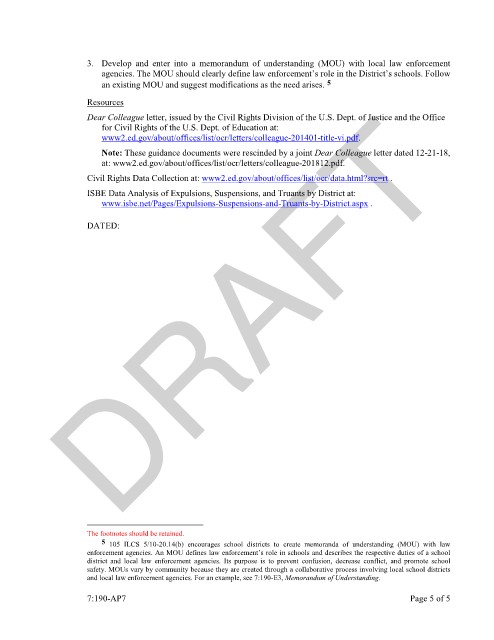Page 1135 - draft
P. 1135
3. Develop and enter into a memorandum of understanding (MOU) with local law enforcement
agencies. The MOU should clearly define law enforcement’s role in the District’s schools. Follow
5
an existing MOU and suggest modifications as the need arises.
Resources
DRAFT
Dear Colleague letter, issued by the Civil Rights Division of the U.S. Dept. of Justice and the Office
for Civil Rights of the U.S. Dept. of Education at:
www2.ed.gov/about/offices/list/ocr/letters/colleague-201401-title-vi.pdf.
Note: These guidance documents were rescinded by a joint Dear Colleague letter dated 12-21-18,
at: www2.ed.gov/about/offices/list/ocr/letters/colleague-201812.pdf.
Civil Rights Data Collection at: www2.ed.gov/about/offices/list/ocr/data.html?src=rt .
ISBE Data Analysis of Expulsions, Suspensions, and Truants by District at:
www.isbe.net/Pages/Expulsions-Suspensions-and-Truants-by-District.aspx .
DATED:
The footnotes should be retained.
5 105 ILCS 5/10-20.14(b) encourages school districts to create memoranda of understanding (MOU) with law
enforcement agencies. An MOU defines law enforcement’s role in schools and describes the respective duties of a school
district and local law enforcement agencies. Its purpose is to prevent confusion, decrease conflict, and promote school
safety. MOUs vary by community because they are created through a collaborative process involving local school districts
and local law enforcement agencies. For an example, see 7:190-E3, Memorandum of Understanding.
7:190-AP7 Page 5 of 5

